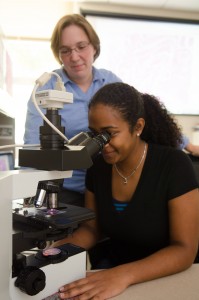Can your laboratory section frozen specimens?
We do not currently have the equipment to produce frozen sections, though we are considering addition of this service in the near future. In the meantime, cryostat sectioning is available through the Delaware Biotechnology Institute (DBI) Imaging Core Facility and the A.I. duPont Children’s Hospital Histology Laboratory.
 Can you perform additional stains beyond H&E?
Can you perform additional stains beyond H&E?
At present, our laboratory only performs special stains for disease organisms commonly encountered in diagnostic service (Gram stain, GMS, etc.). We can advise laboratories on other stains which may be applicable for a specific area of interest and can order and perform these additional staining procedures upon request. Please contact the pathologist for more information.
Do I have to submit tissues in cassettes?
We welcome submission of fixative containers with either pre-trimmed tissues in cassettes or untrimmed tissues. Feel free to contact the pathologist if you require assistance with tissue collection and handling or proper orientation in cassettes. Trimming your own tissues is also a way to save on service fees and cassettes can be provided by our laboratory for a nominal cost. However, tissues do not have to be submitted in cassettes, and our histotechnician routinely trims specimens submitted to our service. Specimens MUST be submitted in an adequate volume of fixative (if unsure what to use, see “Choosing a Fixative”) regardless of whether they are whole or pre-trimmed in a cassette. Containers with formalin must have appropriate formalin-hazard labels. For further information, please read “Submitting a sample”
Can I cut and embed my own tissues using your equipment?
We can also train users on proper embedding techniques upon request. Trained users can then self-embed tissues at our embedding station upon arrangement with the histotechnician. Due to liability issues and potential costs related to service and repair following non-technician use, we cannot currently allow clients to perform microtomy (sectioning) using our equipment.
What information should I provide to the pathologist reviewing slides?
Just as you would not want your doctor to attempt diagnosis of an illness without hearing about your symptoms and performing a physical examination, the pathologist needs to be informed of important clinical and specimen information before microscopic analysis. This information includes:
- Animal information- species, breed, sex and castration status, age
- Clinical information- duration and signs of disease, results of other diagnostic testing
- Specimen information- the organ or tissue and specific anatomic location of each specimen, how the specimen was collected, and gross lesions observed in the specimen. For lesions, please describe: size (measure if possible), shape, color, consistency, distribution.
NOTE: The pathologist typically does not observe the gross specimen prior to tissue processing and sectioning. It is imperative to describe what you saw in the body and specimen prior to trimming and fixation.
Clinical reasoning- What insight are you hoping to gain from microscopic tissue analysis? What lesions are you expecting the pathologist observe (for experimental disease agent exposures)? What is/are your working diagnosis or differential diagnoses?
Research protocol- experimental groups, known disease exposure, group treatments and time course, etc. (for research cases only). Additional protocol sheets can be attached to the submission form as needed.
A summary of the information listed above should be provided with the specimen accession form [Link to Accession Form]. Printed protocols and other supplemental information (digital photos, diagnostic test reports, etc.) can be attached to the accession form if necessary.




